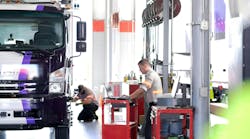In the Oklahoma district of the United States Postal Service (USPS), vehicle maintenance technicians have been taking new pride in their craft since they moved to a team-oriented approach to maintenance. Here's how it works: Teams are formed by assigning groups of drivers and their delivery trucks to specific technicians for all their preventive maintenance and repair needs.
Instituted in 1999 by Lew Flowers, manager, vehicle maintenance, the maintenance team concept has instilled in technicians a higher sense of responsibility to the drivers and vehicles placed under their care. The result, Flowers notes, has been an increase in the ratio of time technicians spend on preventive maintenance vs. unscheduled repairs.
“Over half our technicians are also ASE-certified,” says Flowers. “We started a voluntary program in our district to help technicians improve their skills by encouraging them to become involved in the ASE certification process. We reward those who have successfully passed the tests by publicly recognizing their accomplishments.”
Flowers, a 25-yr. veteran of the USPS, has spent most of his career at the National Center for Employment Development in Norman, OK, training automotive technicians in fleet management for the postal service. In his current position as district manager-vehicle maintenance, he is responsible for maintenance of the Oklahoma District's fleet.
The district has three maintenance shops located in Tulsa, Oklahoma City and Lawton. Within the three facilities there are currently 51 maintenance employees, including automotive technicians, body shop personnel and clerical support staff.
“One thing USPS did this year that is proving to be a major cost-cutter,” Flowers says, “was to institute a nationwide parts consignment program we call Managed Inventory. Basically, we no longer tie up money for long-term parts storage, and we pay for parts only after they are actually used on a truck. Each district works with one of two vendors authorized by USPS to provide this service. We use an Electronic Data Interchange order processing system with bar coding technology; when a part is used, the information goes into the computer system. Each night the data is transferred to the vendor who tracks our usage and replenishes us with new parts every two weeks.”
The USPS is also saving money on tires this year. “Last October we entered into an exclusive agreement with Goodyear that benefits both USPS and employees. In addition to our national buying power, which gets us a good price on Goodyear tires for our fleet vehicles,” Flowers explains, “all postal employees can receive discounts on personal purchases of tires and services at Goodyear facilities. Goodyear will track these purchases and at the end of the year send the USPS a rebate based on the total amount employees spend with them.”
The Oklahoma District fleet, which numbers close to 2,000 vehicles, is largely made up of 3,500-lb. walk-in vans used for mail delivery, along with 14,000-lb. walk-ins, 24-ft. Class 7 cargo vans used for transporting mail and a various assortment of administrative support vehicles. The cargo vans are mostly Fords, while the walk-in delivery vans are a combination of Workhorse, Freightliner and Chevy S10 chassis with Grumman bodies.
Flowers notes that over 200 of the District's vehicles are powered with bi-fueled CNG. Recently procured delivery vehicles, which use a Utilimaster body mounted on a Ford chassis, are called flexible fuel vehicles because of their ability to run on E85 (ethanol) as well as gasoline.
“The delivery trucks are spec'd to last us for 24 years,” Flowers advises. “They have heavy-duty batteries and starters, as well as all-aluminum body parts. USPS is constantly evaluating components, looking at failures from computer data and replacing parts with more durable ones.”
On its cargo vans and tractors, for example, USPS has gone to fully automatic transmissions based on findings from VMRS coding that showed a high incidence of clutch repairs. Flowers says repair costs have gone down since switching to the automatics.
A past chairman of the Technology & Maintenance Council (TMC), Flowers is currently chairman of the group's task force on Vehicle Maintenance Reporting Standards, and is involved with TMC's Future Truck Program.


